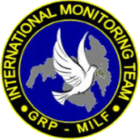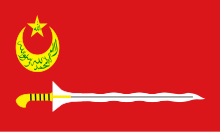International Monitoring Team
The International Monitoring Team (IMT) is a monitoring team composed of 60 members headquartered in Cotabato City, Mindanao of the Philippines to monitor the implementation of peace between the Government of the Philippines (GPH) and one of the largest rebels in the region, the Moro Islamic Liberation Front (MILF) in the Moro conflict. The team is led by Malaysia,[1] and followed by Brunei Darussalam,[2] Indonesia,[3] Japan,[4] Libya,[5] Norway[6] and subsequently the European Union.[7]
| International Monitoring Team | |
|---|---|
 | |
| Abbreviation | IMT |
| Agency overview | |
| Formed | October, 2004 |
| Volunteers | 60 |
| Jurisdictional structure | |
| Operations jurisdiction | Philippines |
| Legal jurisdiction | Mindanao |
| Operational structure | |
| Headquarters | Cotabato City, Philippines |
| Multinational agency | Philippines |
| Nationalities of personnel | 6 countries and 1 supranational union
|
History
The IMT was launched in October 2004 by Malaysia together with Brunei and Libya to oversee the situation after GPH and MILF signing their ceasefire agreement in 2003.[8] In October 2006, Japan began to participate into the monitoring team.[4] Armed conflict however still resumed and security situation deteriorated until August 2008 when the national co-ordination surrounding resolutions of pending land problems failed.[4] During the period, the lead was taken by Libya which then raise sceptism from the MILF over the slowing process.[9] Malaysia then decide to withdrew its contingent in November 2008 and the IMT temporarily suspend its activities in 2009.[4] The IMT returned in February 2010,[10] the same year when Norway began to join the monitoring team.[11] While Indonesia joined the IMT in 2011 after being invited by the Philippines in 2009.[12]
Roles
IMT is responsible to monitor the security, humanitarian, rehabilitation and development aspects, socio-economic assistance and civilian protection.[1]
Areas coverage
IMT covering the areas of Zamboanga del Norte, Zamboanga Sibugay, Zamboanga del Sur, Maguindanao, North Cotabato, South Cotabato, Bukidnon, Lanao del Norte, Lanao del Sur, Sultan Kudarat, Sarangani, Davao del Norte, Compostela Valley, Davao del Sur, Davao Oriental, Basilan, Sulu, Tawi-Tawi and Palawan.[1]
References
- "Terms of Reference of the International Monitoring Team (IMT)". Office of the Presidential Adviser on the Peace Process. November 21, 2016. Retrieved March 12, 2017.
- "International Monitoring Team in Mindanao". Radio Televisyen Brunei. September 5, 2014. Archived from the original on April 16, 2017. Retrieved March 12, 2017.
- "Tim Pengamat Indonesia dalam International Monitoring Team di Filipina Selatan" (in Indonesian). Jaringan Dokumentasi Dan Informasi Hukum, Kementerian Riset, Teknologi dan Pendidikan Tinggi. February 24, 2012. Retrieved March 12, 2017.
- "Resumption of Dispatch of Development Experts to the International Monitoring Team in the Philippines". Ministry of Foreign Affairs, Japan. February 26, 2010. Retrieved March 12, 2017.
- "Libya Increases Participation in Mindanao Peace Process". The Tripoli Post. May 13, 2007. Retrieved March 12, 2017.
- "Norway supports peace process, takes active role in the decommissioning process". Royal Norwegian Embassy in Manila. February 27, 2015. Retrieved March 12, 2017.
- "(Press Release) EU confirms willingness to participate in International Monitoring Team (IMT) in Mindanao" (PDF). European Union. May 18, 2010. Retrieved March 12, 2017.
- Peng Er Lam (June 2, 2009). Japan's Peace-Building Diplomacy in Asia: Seeking a More Active Political Role. Routledge. pp. 80–. ISBN 978-1-134-12506-7.
- "MILF skeptical over Libya lead role in IMT". GMA News. May 14, 2008. Retrieved March 12, 2017.
- "Hopeful signs for end to Mindanao conflict". IRIN News. April 23, 2010. Retrieved March 12, 2017.
- 张茜 (June 7, 2010). "Norway joins int'l group monitoring Mindanao peace process". Xinhua News Agency. People's Daily Online. Retrieved March 12, 2017.
- "Indonesia joins the International Monitoring Team". Government of the Philippines. April 11, 2011. Retrieved March 12, 2017.

